Menu

Did you know the 35th Annual Organic Farming Conference in La Crosse, Wisconsin, showed how working together can transform farming? Over 2,500 from the Organic Seed Commons network came together. They shared how cooperating boosts sustainable farming for all.
Working together in organic farming allows farmers to benefit from each other’s skills. Through trust and joint commitment to sustainable farming, they share resources. This teamwork allows for more crops, lower costs, and supports an eco-friendly community. Projects like those linked with the University of Wisconsin Madison and Seedlinked help create new crops ready for future challenges.
Organic farming has long involved shared ideas and efforts. It’s about farmers teaming up. They do this to combine their skills, knowledge, and tools, boosting what they can achieve together. This approach helps them help each other and do better in their fields.
In the past, working together was key for farming groups. They needed each other to survive. This led to a tradition of working jointly that still stands today. Things have evolved over time, becoming more formal and structured. For example, the USDA has put $81.5 million into improving these efforts in the last two years.
Collaboration in organic farming takes many forms. From friendly deals between neighbours to official business arrangements, there’s a wide range. Here are a few ways it shows up:
The big plus of working together is sharing what you have. This means sharing tools, knowledge, and land. Working together boosts what you can achieve. It builds a sense of community and responsibility too.
The roots of working together in farming go way back. In the past, it was vital for farming groups to help each other. Today, the push for working together comes from the need to tackle bigger problems, like the economy and the environment. With many farming areas going organic, this is a big step forward.
There are now many ways for farmers to join forces, no matter their size. These include everything from simple agreements to full support for newcomers through programs like incubator farms. The support from the USDA shows a strong effort in supporting these models.
Looking ahead, the history of coming together in farming is shaping its future. It’s clear that working together is vital for a sustainable and effective organic farming world.
Joining hands in organic farming has benefits for both the economy and community. It lets farmers combine their resources for better outcomes. This improves their farming methods and makes them more money.
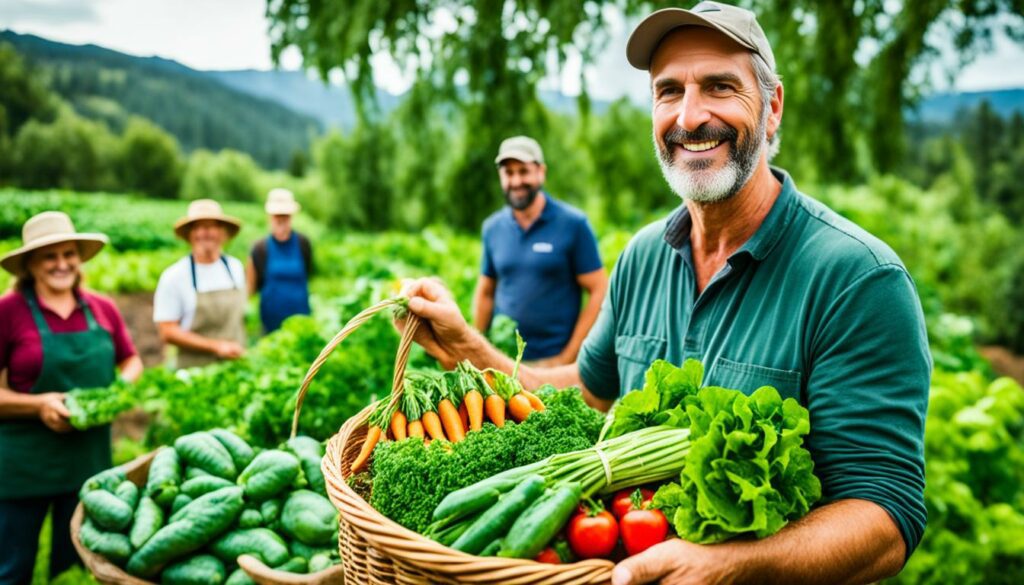
Farmers can share equipment, infrastructures, and efforts to sell produce. By working informally with their neighbours, they cut down on what they individually spend. This makes their farming practices cost less.
New farmers can get tools, land, and entry to markets easily at incubator farms. This helps them start farming without spending a lot of money. It’s a way to farm that’s good for the pocket.
In a farming community that works together, everyone helps each other reach their goals. This makes it easier to succeed in both social and money-making aims of farming sustainably.
Farmers learn a lot from each other in organic farming groups. This includes learning the best ways to farm and special techniques. For new farmers, being at incubator farms means getting taught by seasoned pros.
This sharing of wisdom and skills doesn’t just help individual farmers. It builds a stronger community overall. It’s like everyone is teaching and learning from each other, which helps all farms get better and grow together.
Working together in farming doesn’t just save money; it gets things done better. Groups of farmers can negotiate better, invest together, and are more likely to get funds. This helps both in making money and having a stronger community in the organic farming world.
But the benefits of working together in farming aren’t just about business. They help build a friendly and helpful farming community. This community way of farming is key to success in the world of organic growing.
In the world of organic farming, different types of teamwork have become popular. From simple agreements between nearby farmers to more complex partnerships like cooperatives, there are many ways farmers are working together. These collaborations are changing the face of sustainable farming.
In simple setups, farmers help each other by sharing their skills and tools. This way of working together is easygoing and doesn’t need any official contracts. But, it can mean that there are fewer benefits and less support compared to more organised groups.
Incubator farms are also becoming a key way for new farmers to get started. These farms offer not just land and tools, but also advice and support. They help new farmers learn how to run a successful organic farm.
Working together isn’t always easy. Sometimes partners disagree on how to do things or how to split the profits. Also, not everyone might put in the same amount of work. That’s why more formal groups, like cooperatives and LLCs, can help. They set clear rules on how to share resources and run the business.
In Denmark, sharing manure is a big deal in organic farms. Most organic dairy farmers work together on managing manure. Also, many organic crop farms have deals with livestock farms. This shows how important teamwork is in boosting sustainability and farm health.
| Characteristic | Organic Partnerships | Conventional Partnerships |
|---|---|---|
| Average number of collaborative activities | 2.3 | 1.6 |
| Additional activities beyond manure arrangements | 80% | 70% |
In the world of organic farming, informal arrangements are key for community farming support. Farmers come together in local, informal networks. They help each other without needing written contracts. This boosts community spirit and working together.
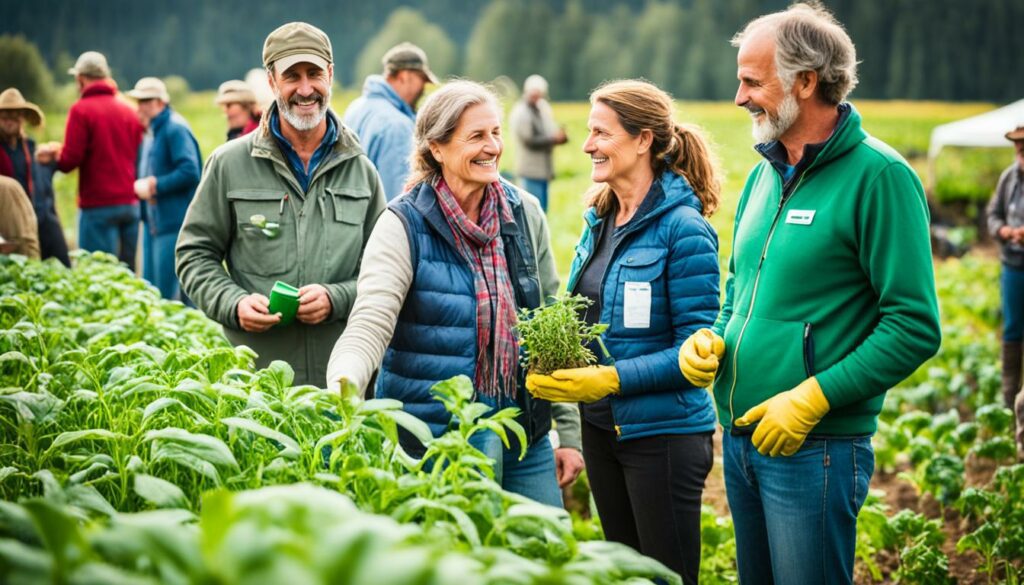
Support between farmers in the same area is vital. They often work together on big tasks or loan tools. This way, they use resources better and build stronger ties. At places like the Copake Agricultural Center, farmers join forces to help and learn from each other.
Informal partnerships have their own set of good and bad points. The positives are:
However, there are also challenges to face in such partnerships:
It’s important for farmers to weigh these positives and negatives before diving into informal arrangements. Being ready for the partnership to end is also crucial. A clear exit plan protects everyone and ensures a stronger farming community in the long run.
Incubator farms help new farmers get a good start in sustainable agriculture. They offer resources and support to those just starting. The goal is to see more farmers succeed in sustainable farming. Such programmes are key to growing new talents in farming.
Agricultural incubators show that giving resources works in sustainability. Urban Edge Farm in Providence stands out. It gives new farmers land, tools, advice, and chances to sell their goods. Viva Farms and the Elma C. Lomax Incubator are also big helpers. They play a major role in getting new farmers up and running.
Incubator farms help new farmers overcome big hurdles. They provide things like affordable land and equipment. They also offer training, mentorship, and networking chances. These are all crucial in starting a new farming business.
In parts of Central Texas, growing local food is very rare. Almost 17 acres of farmland disappear each day. The Farmshare Austin project aims to fix this. Its goal is to make sustainable farming more equal. This way, more farmers can succeed locally.
They help new farmers and tackle big issues. These include the ageing of farmers and the need for young people in farming. Their work supports the future of farming.
| Programme Location | Key Resources Provided | Outcome |
|---|---|---|
| Urban Edge Farm, Providence | Land access, equipment, mentorship, markets | Established new sustainable farm businesses |
| Viva Farms, Skagit Valley, WA | Comprehensive training, infrastructure, community support | High retention of new farmers |
| Elma C. Lomax Incubator, Cabarrus County, NC | Affordable land, educational programs, mentor engagement | Successful transition to independent farming operations |
Leasing is a key part of sustainable farming, especially for farmers without their own land. This method lets farmers use land without huge buying costs. They sign lease contracts to do this. These agreements can then lead to more organised collaborations in organic farming, promoting fair and open partnerships.
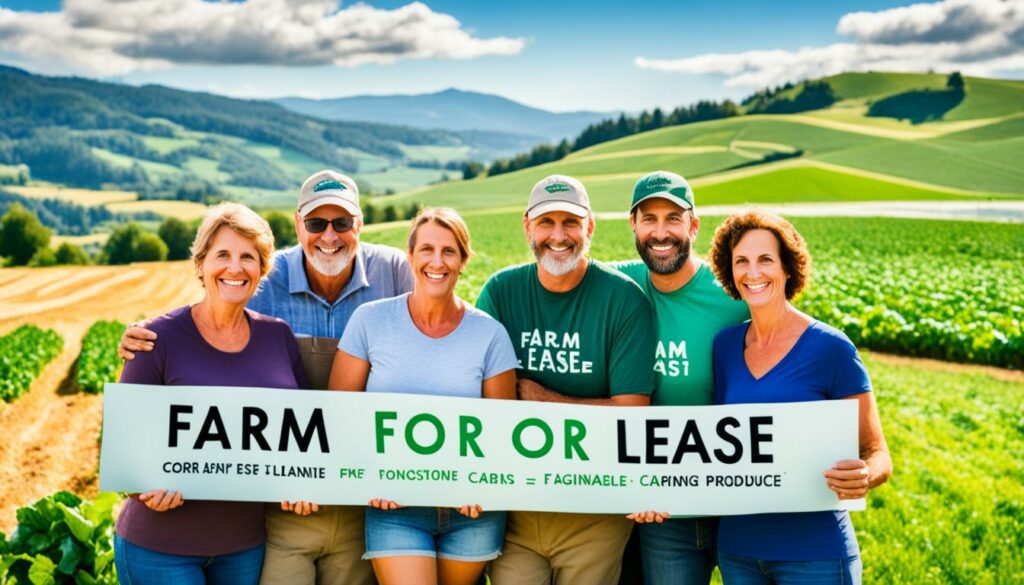
Another big help in encouraging teamwork is forming official agriculture groups. Whether it’s an LLC, partnership, or cooperative, these groups set clear rules for everyone. This clarity helps avoid arguments and ensures everyone shares resources evenly.
Working together legally in organic farming also makes it more reputable and attracts funding. Investors like to see organised projects because they are less risky. This situation promotes smoother teamwork and the chance for more financial support and success in the future.
Over time, the informal farming setups often turn into formal deals. This change highlights the value of starting with informal partnerships. They can evolve into something stable and beneficial for all over the long term.
Using leases and forming official farming groups help create strong alliances. These alliances aid in the growth, safety, and knowledge sharing within the organic farming sector.
Agricultural cooperatives are crucial for organic farming. They allow farmers to work together on challenges. These include production, marketing, and distribution.
Benefits of farming cooperatives include reducing costs and improving market access. They also provide shared knowledge and resources. By banding together, farmers get more bargaining power. This helps them do better in markets.
Cooperative models offer big advantages. Farmers pool resources like land and equipment. This cuts costs and lowers the effort for each individual. It makes farming more efficient.
They also provide a space for sharing skills and knowledge. This helps everyone grow together. Successful cooperatives tend to have better market access. They can bargain from a stronger position. In Argentina, for example, these groups manage 80% of the farmland. This shows their significant role in agriculture.
There are many great examples of agricultural cooperatives. For instance, the Organic Valley in the U.S. It has 1,800 family farms working together towards sustainability. In Florida, the Natural citrus co-op is also thriving. This is despite facing tough competition.
Globally, there are more than 1.2 million farming cooperatives. They support farmers in many ways. In Canada, for example, there are over 1,200 rural cooperatives showing their success.
| Country | Number of Cooperatives | Impact |
|---|---|---|
| Argentina | Multiple | Manage 80% of farmland |
| United States | Various (including Organic Valley, Florida’s Natural) | $22.2 billion in revenue (2020) |
| Canada | 1,200+ | Extensive rural support |
These cooperatives serve as great examples. They show the power of working together in farming. They help in driving sustainable yet profitable farming. This ensures the economic well-being of their members. Agricultural cooperatives are key in creating strong communities. They also help in promoting eco-friendly and sustainable agriculture.
Working together on organic farms can bring big benefits like more crops and savings. But, it comes with challenges. It’s important to know these and find ways to fix them for strong and lasting farm partnerships. I’ll talk about problems in working together on farms and how to solve them to make partnerships work better.

Good communication is key for farming partnerships but can be hard. People might not agree on how much effort to put in or what they expect. Sharing profits is also a big challenge and needs a fair plan. The price of organic grains can change a lot, making it tricky to stay financially stable.
Overcoming these challenges means finding good ways to work together on farms. Talking often and making sure everyone understands each other is crucial. It’s also important to set goals together and have official agreements to avoid disagreements.
Helpful programs like the Organic Transition Premium can lessen the impact of changing grain prices. It shows a way to support organic grain farmers during tough times.
Groups like the U.S. Organic Grain Collaboration improve conditions for all grain growers by working together. They help in setting fair prices and reducing risks. Getting advice from trusted experts and growing your farmer connections can also help everyone learn and support each other.
| Challenges | Practical Solutions |
|---|---|
| Effective Communication | Regular meetings, clarity in roles and responsibilities |
| Profit Sharing Disputes | Equitable profit-sharing agreements, transparent financial strategies |
| Volatile Organic Grain Prices | Implement programs like Organic Transition Premium, collective bargaining |
| Varied Commitment Levels | Setting shared goals, formal agreements |
Success in farming partnerships needs good planning and a flexible approach to working together. Tackling these shared issues directly can lead to a successful and harmonious way of farm collaboration. This journey is key to sustainable and planet-friendly agriculture.
Creating fruitful partnerships in organic farming is key to growth and sustainability. The first step is finding partners who have the same dreams and work with similar values. It’s also important to make clear what you want to achieve together. This makes the relationship work well.
To start a good partnership, look for those who love organic farming like you do. They should bring different skills and have what you need, like labour and tools. Being part of an organic farming group can help you connect with the right partners.
Once you find possible partners, it’s important to agree on shared goals. Good communication is vital. Talk about how to split work, costs, and who does what. Know where you’re going together by sharing a clear vision.
| Key Resource Areas | Shared Benefits | Potential Challenges |
|---|---|---|
| Skills & Knowledge | Enhanced expertise and innovation in farming techniques | Knowledge-sharing disputes |
| Labour & Equipment | Cost reduction and increased efficiency | Unequal effort or commitment |
| Infrastructure & Land | Optimised use of space and facilities | Difficulties in shared use of resources |
| Business Plans & Marketing | Streamlined operations and better market reach | Variances in business strategies and shared customer base issues |
Joining forces can bring great benefits, but there are challenges too. Things like not agreeing on how to share profits or issues with working together are common. However, by talking openly and agreeing clearly on what to do, these can be worked through.
In summary, forming strong collaborations in organic farming means working towards the same goals while understanding and respecting each other’s roles. It’s vital to keep talking and adjusting your plans to fit changing circumstances. This way, your partnership can lead to a more successful future in sustainable agriculture.
Looking at successful farm collaborations gives us great ideas. The story of Urban Edge Farm and Spencer Blackwell shows how working together achieves big results. These tales from the world of organic farming can teach and motivate others in the field.
Urban Edge Farm is a perfect model of working together in farming. It helps new farmers with land, tools, advice, and ways to sell their produce. This way of farming encourages methods that take care of the land for the long term.
Researchers in the EU looked at 30 farming groups that work together. They found that two big things from outside, five from the people involved, and five about how they worked together all made a difference. This shows that what happens inside these groups is more important than things they can’t control from the outside.
At Urban Edge Farm, success is about how well everyone communicates and works towards the same goals. They found a way to make social and financial goals work together. This helped everyone.
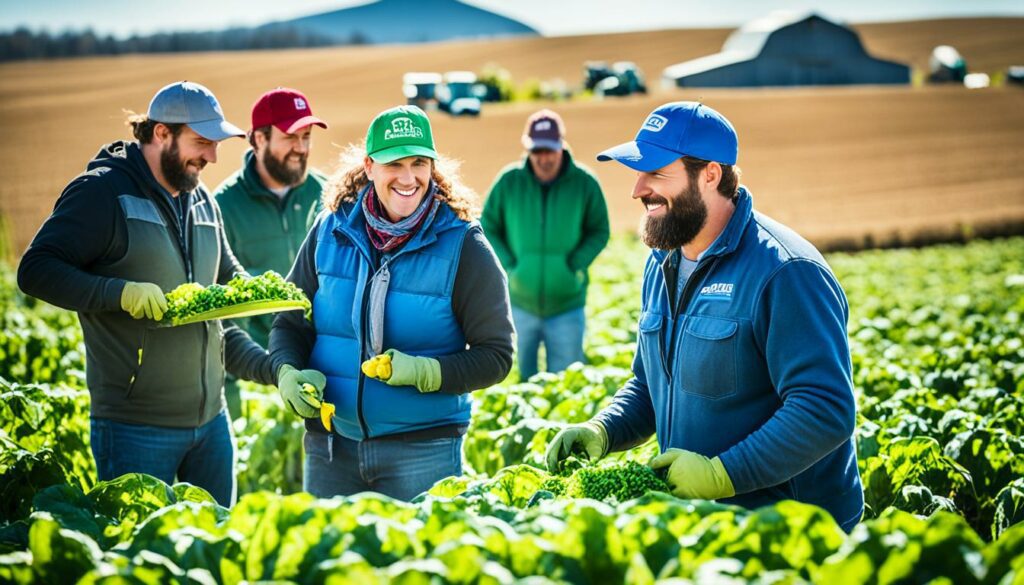
Spencer Blackwell began his farm journey at Urban Edge Farm’s startup program. With shared tools and advice, he built a strong plan and farming skills. Later, he became a farm owner, thanks to the help he got from working with others.
Spencer’s story shows how farming together can help everyone win. Incubators like Urban Edge Farm make it easier for new farmers, cutting down on early struggles. This way, farming can be a lasting and shared success.
| Factor | Impact |
|---|---|
| External Factors | Moderate |
| Actor-Related Factors | High |
| Organization and Management Factors | High |
In the chart, you see that the people part and how they organise matter a lot in farming together. Stories like Spencer’s show how important it is to team up well. This helps beat challenges and grow sustainably.
Exploring legal frameworks in farming collaborations is vital for stable organic farming partnerships. It covers everything from casual deals to more formal setups. Knowing the organic farming laws is crucial. For example, laws in Massachusetts and California explain the legal side of these partnerships.
It’s important to follow state laws in places like Tennessee, Nebraska, and Vermont when working together. The cases of Stepney LLC vs. Town of Fairfield and Lindstrom vs. Panhandle District Board show why knowing about agricultural legal entities matters. The legal guide on contract farming and the Principles for Responsible Investments help too.
Actions like the Ohio Ex-Offender Reentry Coalition’s plan and those by councils show the wide effects of legal structures. Things like the New York City child fatality report also shed light on how organic farming laws impact collaborations.
Looking at real-life examples, such as Elmer Farm’s growth, we see common challenges. Legal orders in places like New Jersey and Philadelphia highlight how laws change and guide these farmers.
Getting to know agricultural legal entities is key for new farmers wanting to work together. As legal needs change, it’s crucial to keep up. This helps create strong and lasting organic farming partnerships.
Collaborative organic farming is set to grow fast. This growth is fuelled by new trends and partnerships in farming. These new ways of working will include high tech, green practices, and better ways to share knowledge.
From 2012 to 2020, the EU’s organic area shot up by 56%. There was also a 40% rise in organic producers and a huge 114% jump in the sales’ value. This big increase shows how important teamwork is in pushing organic farming ahead. It also matches a worldwide interest in green farming.
In 2020, Spain had 2,437,891 hectares of certified organic land, making it Europe’s second leader. Around 45% of Spain’s organic products go to other countries in Europe. This shows the key role of global teamwork. The Valencian Region in Spain saw a big 135% increase in its organic land over ten years.
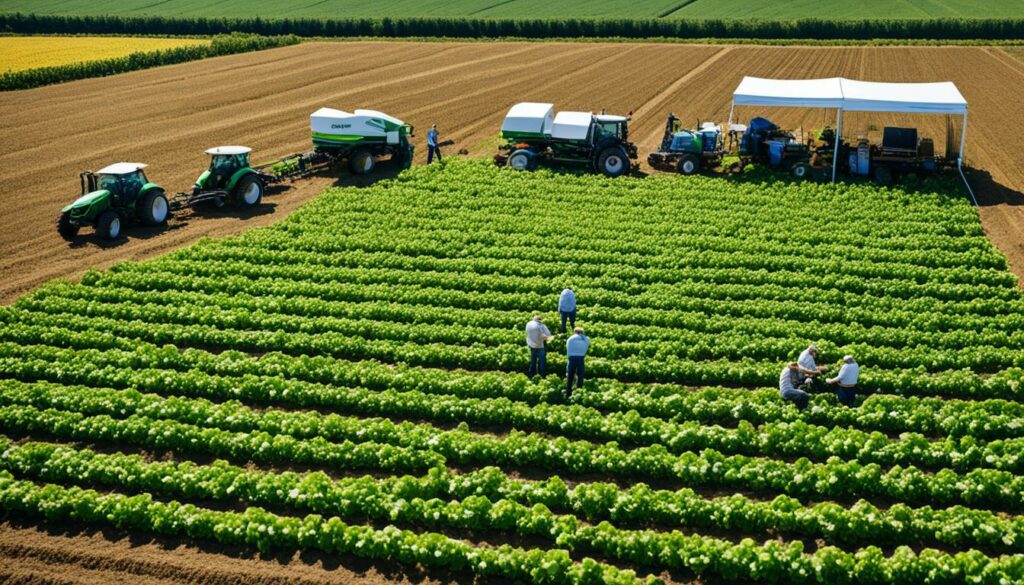
Future farming will use new tech to be more productive and green. The precision farming market is set to hit $16.35 billion by 2028. Innovations like CEAT Specialty’s Galileo Cup-Wheel and SustainMax tyres are leading the way in eco-friendly farming. These products cut soil damage and use sustainable materials.
A big challenge is dealing with climate change. By 2050, we’ll need 70% more food. This means we must farm smarter. Learning and sharing new tech among farmers can lessen the impact of climate change and boost farming’s success.
In the UK, farms are already working together and using new tech. These efforts not only help each farm be more productive. They also make a stronger, united farming community. Using smart farming and precision farming can save water and lower waste, making a greener future.
| Country | Organic Area (ha) | % Increase (2012-2020) | Export Percentage |
|---|---|---|---|
| European Union | n/a | 56% | n/a |
| Spain | 2,437,891 | n/a | 45% |
| Valencian Region (VR) | 153,503 | 135% | n/a |
| Global Precision Farming Market | n/a | n/a | $16.35 billion by 2028 |
In conclusion, new trends in organic farming and teamwork are about to change how we farm. Embracing new partnerships and tech can make a strong, green future for farming.
Reflecting on the 30 case studies, the power of group work in farming is clear. Through sharing ideas, farmers learn to deal with challenges better. They create a future that is both green and profitable. This way of working shows that together, we can build a stronger farming world.
The studies found that what happens inside the group matters most. This is more important than what’s going on outside. It shows that the group’s own actions are key to success. Even the start-up phase is less important than later teamwork.
Working together in farming has a lot of good results. It makes things more efficient and helps with costs. It also gives farmers more power when dealing with others and helps them get money. But, the benefits go beyond cash; they also help the community grow stronger.
The organic farming world is growing fast. More land and more money are being turned towards it every year. This shows that people are starting to work together more. By doing so, they make farming greener and more successful. They prove that by uniting, we can make a difference.
Organic farming collaboration is when farmers team up to share resources. This includes knowledge, skills, and tools. They work together to achieve a common environmental goal.
The act of sharing and helping each other has been around since early farming communities. It began with taking care of fields together. Now, it has developed to work on today’s organic farming challenges in a modern way.
Working together cuts costs and boosts productivity. It allows for the sharing of important farming tips and tools. These collaborative efforts push forward eco-friendly practices.
Organic farmer partnerships vary. Some are friendly, informal helps between neighbours. Others are more structured, like cooperatives or LLCs. There are also incubator farms supporting new farmers.
Incubator farms offer new farmers a chance to learn. They provide access to land, equipment, and teachings. By doing this, they help grow sustainable farming futures.
By leasing land and setting up businesses, farmers gain structure and clear roles. This attracts finance and ensures long-term teamwork. These models support organic agriculture group efforts.
Agricultural cooperatives allow farmers to work together in producing and selling. They benefit from teamwork by becoming stronger in the market. This approach supports sustainable farming and financial success.
Problems like disagreements and fairness in sharing gains can occur. Addressing these involves open talks and clear goals. It’s about making sure everyone knows their part for a smooth process.
Choose partners who think alike and want the same end results. Make sure everyone knows what the goals are from the start. This heads towards making better, sustainable farming moves together.
Yes, like the story of Urban Edge Farm and Spencer Blackwell. They show how working together can improve results for everyone. Such examples highlight the value of farming partnerships.
Knowing the legal side ensures partnerships are stable and true to their goals. Each legal form has its own rules. Understanding and following them helps things run smoothly.
The future might see more advanced and vibrant partnerships. Technology and new practices will likely play a big role. These changes aim to make farming sustainable and strong.